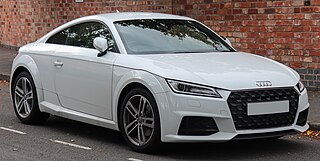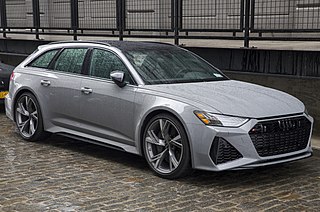
The Audi A6 is an executive car made by the German company Audi since 1994. Now in its fifth generation, the successor to the Audi 100 is manufactured in Neckarsulm, Germany, and is available in saloon and estate configurations, the latter marketed by Audi as the Avant. Audi's internal numbering treats the A6 as a continuation of the Audi 100 lineage, with the initial A6 designated as a member of the C4-series, followed by the C5, C6, C7, and the C8. The related Audi A7 is essentially a Sportback (liftback) version of the C7-series and C8-series A6 but is marketed under its own separate identity and model designation.

The Audi TT is a production front-engine, 2-door, 2+2 sports coupé and roadster, manufactured and marketed by Audi from 1998 to 2023 across three generations.

The Audi 80 is a compact executive car produced by the Audi subdivision of the Volkswagen Group across four generations from 1966 to 1996. It shared its platform with the Volkswagen Passat from 1973 to 1986 and was available as a saloon, and station wagon — the latter marketed by Audi as the Avant. The coupé and convertible models were not badged as members of the range, but used a derivative of the same platforms.

The Audi A3 is a subcompact executive/small family car (C-segment) manufactured and marketed by the German automaker Audi AG since September 1996, currently in its fourth generation.

The Audi A8 is a full-size luxury sedan manufactured and marketed by the German automaker Audi since 1994. Succeeding the Audi V8, and now in its fourth generation, the A8 has been offered with both front- or permanent all-wheel drive—and in short- and long-wheelbase variants. The first two generations employed the Volkswagen Group D platform, with the current generation deriving from the MLB platform. After the original model's 1994 release, Audi released the second generation in late 2002, the third in late 2009, and the fourth and current iteration in 2017. Noted as the first mass-market car with an aluminium chassis, all A8 models have used this construction method co-developed with Alcoa and marketed as the Audi Space Frame.

The Audi A5 is a series of compact executive coupé cars produced by the German automobile manufacturer Audi since June 2007. The A5 range additionally comprises the coupe, cabriolet, and "Sportback" version of the Audi A4 saloon and estate models.

The Audi A4 is a line of luxury compact executive cars produced since 1994 by the German car manufacturer Audi, a subsidiary of the Volkswagen Group. The A4 has been built in five generations and is based on the Volkswagen Group B platform. The first generation A4 succeeded the Audi 80. The automaker's internal numbering treats the A4 as a continuation of the Audi 80 lineage, with the initial A4 designated as the B5-series, followed by the B6, B7, B8, and the B9.

The Audi Q7 is a crossover SUV made by the German manufacturer Audi, unveiled in September 2005 at the Frankfurt Motor Show. Production of this seven-seater SUV began in the autumn of 2005 at the Volkswagen Bratislava Plant in Bratislava, Slovakia.

The Audi S4 is the high performance variant of Audi's compact executive car A4. The original Audi S4, built from 1991 until 1994, was a performance-oriented version of Audi's 100 saloon/sedan. All subsequent S4s since 1997 have been based on the Audi A4; and as the A4 has evolved from one generation to the next, so has the S4.

The Audi RS 6 is a high-performance variant of the Audi A6 range, produced by the high-performance subsidiary company Audi Sport GmbH, for its parent company Audi AG, a subsidiary of the Volkswagen Group, from 2002 onwards.

The Audi RS 4 is the high-performance variant of the Audi A4 range produced by Audi Sport GmbH for AUDI AG, a division of the Volkswagen Group. It sits above the Audi S4 as the fastest, most sports-focused car based on the A4's "B" automobile platform. The RS 4 was reintroduced in 2012, based on the A4 Avant instead of the sedan as did the original model.

Audi S and RS models are a range of high performance versions of certain car models of the German automotive company Audi AG. These cars primarily focus on enhanced "sport" performance. Production of Audi "S" cars began in 1990 with the S2 Coupé, whilst the first "RS" car appeared four years later with the Audi RS 2 Avant.

Audi hybrid vehicles are hybrid electric vehicles created by the German carmaker, Audi. Some vehicles listed were concept vehicles, which utilised an internal combustion engine and an electric motor, and were used for research and development (R&D) for potential future use of the technology into possible series production. Audi launched its first hybrid concept car in 1989 called the Audi Duo, and was the first European company to sell a hybrid in 1997, though only in very small numbers.
Audi Sport GmbH, formerly known as quattro GmbH, is the high-performance car manufacturing subsidiary of Audi, itself a subsidiary of the greater Volkswagen Group.

The Audi S5 is one of two high-performance variants of Audi's A5. It is also the coupé, cabriolet, and five-door fastback sedan versions of the fourth-generation (B8) Audi S4 saloon and estate models.

The Audi A7 is an executive five-door liftback coupé produced by Audi since 2010. A luxury car, it features a sloping roofline with a steeply raked rear window and integrated boot lid, and four frameless doors. It is also available as a three-box, four-door saloon in China since 2021.

The Audi RS 2 Avant is a high-performance version of the Audi 80 Avant estate car, manufactured from March 1994 to July 1995. Collaboratively designed as a joint venture between Audi AG and Porsche and based on Audi's B4/8C platform, it received the internal designation of P1. It featured the most powerful version of Audi's inline-five cylinder turbocharged engine. It represents Audi's first "RS" model, and the first of their high-performance Avants.

Volkswagen Group have produced a number of W12 internal combustion piston engines for their Volkswagen, Audi, and Bentley marques, since 2001.

The Volkswagen-Audi V8 engine family is a series of mechanically similar, gasoline-powered and diesel-powered, V-8, internal combustion piston engines, developed and produced by the Volkswagen Group, in partnership with Audi, since 1988. They have been used in various Volkswagen Group models, and by numerous Volkswagen-owned companies. The first spark-ignition gasoline V-8 engine configuration was used in the 1988 Audi V8 model; and the first compression-ignition diesel V8 engine configuration was used in the 1999 Audi A8 3.3 TDI Quattro. The V8 gasoline and diesel engines have been used in most Audi, Volkswagen, Porsche, Bentley, and Lamborghini models ever since. The larger-displacement diesel V8 engine configuration has also been used in various Scania commercial vehicles; such as in trucks, buses, and marine (boat) applications.











































